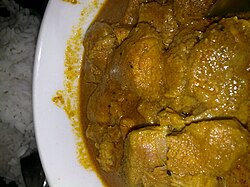Vindaloo
 Pork vindaloo, served in a Goan-style Indian restaurant, 2006 | |
| Alternative names | Vindalho |
|---|---|
| Type | Curry |
| Course | Main course |
| Place of origin | India |
| Region or state | Goa |
| Main ingredients | Pork, vinegar, spices, chili peppers |
Vindaloo or vindalho is a curry dish known globally in its British-Indian form as a staple of curry houses and Indian restaurants, specifically a fiery, spicy dish. Vindaloo's name derives from the quite different Portuguese Goan dish carne de vinha d'alhos (meat with garlic vinegar).[1][2] The Goan recipe is a mildly spiced pork dish, but alternative versions are commonly used, such as beef, chicken, lamb, mutton, prawns, vegetables and tofu.[3]
Mildly-spiced Portuguese Goan dish
[edit]A standard element of Goan cuisine derived from the Portuguese carne de vinha d'alhos (meat in wine and garlic marinade; literally "meat of wine of garlic"[4]), vindaloo is a dish of meat marinated in vinegar and garlic.[5][6] This was adapted by the local Goan cooks with the substitution of palm vinegar for the wine, and the addition of spices, evolving into the localized "vindaloo".[7]
Even though the word aloo (आलू) means potato in Hindi,[8] traditional Goan vindalho does not include potatoes; the name is from Portuguese with no Hindi etymology. Some Indian versions include potatoes due to the confusion with the Hindi aloo, "potato".[9]
-
Pork vindalho, served in Lisbon, Portugal, in a Goan-style Indian restaurant, 2011
Fiery British dish
[edit]The British version of vindaloo calls for the meat to be marinated in vinegar, sugar, fresh ginger and spices, then cooked with more spices.[5] According to the food writer Pat Chapman, Vindaloo served in British restaurants differs from the original vindaloo dish; it is simply a version of the standard medium spicy (Madras) restaurant curry with the addition of vinegar, potatoes and plenty of chili peppers.[10] The British version became widespread with the creation of more Indian restaurants in Britain in the 1970s.[11] The name "vindaloo" was effectively redefined to mean "a very hot curry".[12] Vindaloo has indeed featured in "challenge" competitions to see who can eat such a hot curry.[13]
Vindaloo was introduced to Hong Kong when it was a British colony. In 2020 the food and beverage manager of the Aberdeen Boat Club, Hong Kong described vindaloo as one of the institution's most commonly ordered dishes.[11]
-
Prawn vindaloo with rice, Germany, 2021
-
Lamb vindaloo served in Helsinki, Finland, 2011
See also
[edit]References
[edit]- ^ Menon, Smitha (23 June 2020). "How did the Goan vindaloo get to you?". Condé Nast Traveller.
- ^ Taylor, Anna-Louise (11 October 2013). "Curry: Where did it come from?". BBC Food. Archived from the original on 11 December 2014. Retrieved 17 December 2014.
- ^ Peters-Jones, Michelle. "Indian Classics – Vindalho de Galinha (Chicken Vindaloo)". The Tiffin Box. Archived from the original on 13 July 2015. Retrieved 13 July 2015.
- ^ "Vinha-d'alhos". Priberam (Portuguese Dictionary). Retrieved 27 November 2020.
- ^ a b "Indal (Vindaloo)". The East Indian Community. Archived from the original on 5 July 2015. Retrieved 13 July 2015.
- ^ Deravian, Naz (13 December 2023). "Chicken Vindaloo". NYT Cooking. Retrieved 17 December 2023.
- ^ "How to cook a vindaloo – students learn from the best". University of West London. Archived from the original on 9 November 2012. Retrieved 26 October 2012.
- ^ "Hindi/English/Tamil Glossary". Pravasidesi's Tiffin box. 25 September 2007. Archived from the original on 17 October 2012. Retrieved 26 October 2012.
- ^ Manon, Smitha (23 June 2020). "How did the Goan vindaloo get to you?". Condé Nast Traveler. Retrieved 22 March 2021.
- ^ Pat Chapman (2004). The New Curry Bible. London, UK: Metro Publishing. pp. 118–121. ISBN 978-1-84358-087-4.
- ^ a b Mathur, Bhakti (28 September 2020). "The history of vindaloo, loved in Britain: why India has Portuguese explorers to thank for the famous hot curry". South China Morning Post. Retrieved 11 April 2025.
- ^ Collingham 2007, p. 225.
- ^ "Vindaloo". British Curry Day. Retrieved 16 November 2025.
Sources
[edit]External links
[edit]- Vindaloo at The Foods of England


